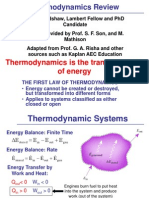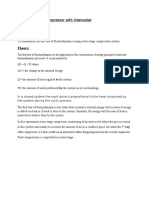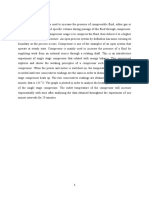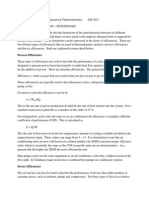Compressor Efficiency: Iso Iso Act
Uploaded by
C. MCompressor Efficiency: Iso Iso Act
Uploaded by
C. MCompressor Efficiency Area 1-2-5-4 = isothermal work of compression for a single stage Area 1-2-3-4 = isentropic work of compression
for a single stage
When the compression takes place in a multi-stage compressor with inter-stage cooling, the work of compression is intermediate between that for single stage isothermal compression and that for isentropic compression. The net saving in energy is shown as the shaded area.
Compressor efficiency is usually quoted as either an isothermal efficiency or an isentropic efficiency. iso = (Wiso/Wact) =
isothermal work for a single stage (eq. 14) actual work (eq. 27) (30)
isen = (Wisen/Wact) =
isentropic work for a single stage (eq. 15) actual work (eq. 27) (31)
Energy balance for a two stage compressor
1Q2 1W2
= net heat transfer across system boundary = net work transfer across system boundary
E1 = initial energy of the system E2 = final energy of the system
From the fist law of thermodynamics: E2 E1 = 1Q2 1W2 m(h2 h1) = 1Q2 1W2 m(h2 h1) = 1Q2 1W2 mCp(T2 T1) = 1Q2 1W2 where: Cp = dh/dT
Applying the First Law of Thermodynamics for a two-stage compressor with interstage cooling. For the low pressure (LP) stage: mCp(Ti T1) = QLP WLP For the cooler: mCp(T1 Ti) = QI For the high pressure (HP) stage: mCp(T2 T1) = QHP WHP (32) (31) (30)
Worked Example 2 A 2-stage compressor compresses air from 1 bar and 15C to 15.5 bar. Calculate the work done per hg of air delivered and the heat rejected from the interstage cooler. Polytropic index, k = 1.3 Specific gas constant = 287 J kg-1 K-1 Specific heat capacity, Cp = 1.005 kJ kg-1 K-1
Worked Example 3 A three stage compressor is required to compress air from 140kNm-2 to 4000 kNm-2. calculate the intermediate pressures, the work done per kg of the gas and the isothermal efficiency of the process. Assume the compression to be isentropic ( = 1.4) and perfect interstage cooling. Show by means of a Temperature-Entropy diagram the effect of imperfect interstage cooling on the performance of the compressor.
You might also like
- Work Done in Compressor - Alighar Muslim UniversityNo ratings yetWork Done in Compressor - Alighar Muslim University8 pages
- 13 - Reciprocating Air Compressors - IINo ratings yet13 - Reciprocating Air Compressors - II27 pages
- 22 Msn20212208 2021 Rp4a 12 Pertemuan Ke 12 Intercooling CompressorNo ratings yet22 Msn20212208 2021 Rp4a 12 Pertemuan Ke 12 Intercooling Compressor3 pages
- Chemical Engineering - Plant Engineering 2 Power RequirementNo ratings yetChemical Engineering - Plant Engineering 2 Power Requirement2 pages
- 18ME54 Turbo Machines Module 01 Question No 2a & 2bNo ratings yet18ME54 Turbo Machines Module 01 Question No 2a & 2b13 pages
- Me 6404 - Thermal Engineering UNIT - IV - Air CompressorNo ratings yetMe 6404 - Thermal Engineering UNIT - IV - Air Compressor34 pages
- UNIT 05_Single Stage Reciprocating CompressorNo ratings yetUNIT 05_Single Stage Reciprocating Compressor30 pages
- JC-Rawls BASF CalculatingCompressorEfficiency100% (1)JC-Rawls BASF CalculatingCompressorEfficiency20 pages
- Efficiency Definitions For Compressors 2021No ratings yetEfficiency Definitions For Compressors 202129 pages
- Interstage Pressures of A Multistage Compressor With IntercoolingNo ratings yetInterstage Pressures of A Multistage Compressor With Intercooling14 pages
- Air Compressors: UNIT-3 Dr. Devendra Kumar PatelNo ratings yetAir Compressors: UNIT-3 Dr. Devendra Kumar Patel15 pages
- Thermodynamics: The First Law of ThermodynamicsNo ratings yetThermodynamics: The First Law of Thermodynamics11 pages
- Thermodynamic Analysis of Gas Compressor: Nishad Dharam Raj, Mirza Shujathullah, Melapundi Dinesh, Patlola Varun ReddyNo ratings yetThermodynamic Analysis of Gas Compressor: Nishad Dharam Raj, Mirza Shujathullah, Melapundi Dinesh, Patlola Varun Reddy4 pages
- School of Engineering Technology Mete123 Thermodynamics Air Compressor ExperimentNo ratings yetSchool of Engineering Technology Mete123 Thermodynamics Air Compressor Experiment4 pages
- MAR 851 - Advanced Marine Engines & Power Plants NEWNo ratings yetMAR 851 - Advanced Marine Engines & Power Plants NEW71 pages
- Lab Report II: Applications of The Second Law of ThermodynamicsNo ratings yetLab Report II: Applications of The Second Law of Thermodynamics9 pages
- Q1. A Gas Turbine Power Plant Operating On An Ideal Brayton Cycle Has A Pressure Ratio of 8. The100% (2)Q1. A Gas Turbine Power Plant Operating On An Ideal Brayton Cycle Has A Pressure Ratio of 8. The12 pages
- Laws of Thermodynamics - Lesson Proper For Week 18No ratings yetLaws of Thermodynamics - Lesson Proper For Week 185 pages
- LECTURE 5: Optimisation of Catalytic ReactionsNo ratings yetLECTURE 5: Optimisation of Catalytic Reactions34 pages
- School of Chemistry and Chemical Engineering SYNOPSIS 2013/2014 Chem. Eng. Level 3, Module CHE3004 Transport Phenomena Module Co-Ordinator: CM25% (4)School of Chemistry and Chemical Engineering SYNOPSIS 2013/2014 Chem. Eng. Level 3, Module CHE3004 Transport Phenomena Module Co-Ordinator: CM3 pages




































































